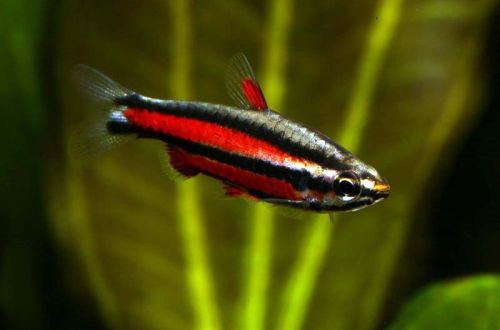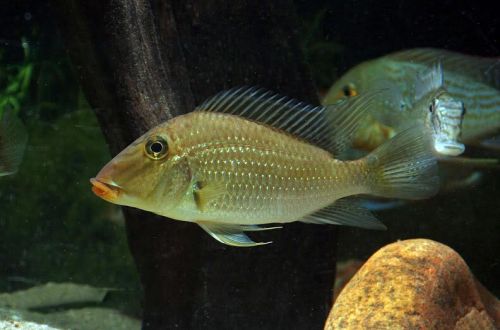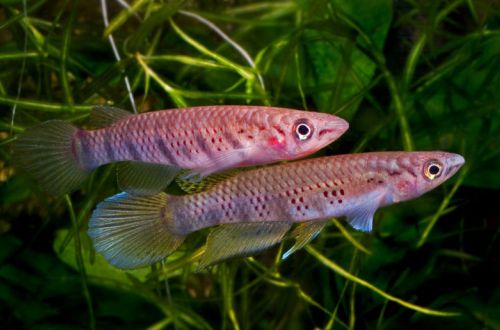
Ruby nannostomus
The ruby nannostomus, scientific name Nannostomus rubrocaudatus, belongs to the Lebiasinidae family. A bright beautiful fish, which, coupled with a relatively simple content, made it possible to gain wide popularity in amateur aquariums.

Contents
Habitat
It originates from South America from the territory of Peru from the Marañon River basin to its confluence with Ucayali, the place where the Amazon was formed. A significant part of the length of the Marañon flows through mountainous and hilly terrain, however, fish prefer regions with a slow current, as well as wetlands with stagnant water.
Brief information:
- The volume of the aquarium – from 80 liters.
- Temperature – 24-28°C
- Value pH — 4.0–7.5
- Water hardness – soft (1-9 dGH)
- Substrate type – any dark
- Lighting – subdued
- Brackish water – no
- Water movement – little or no
- The size of the fish is about 2 cm.
- Meals – any
- Temperament – peaceful
- Keeping a flock of at least 10 individuals
Description
Outwardly, it resembles its close relative, the Red Nannostomus. Adult individuals reach a length of up to 3 cm. Males, unlike females, are larger and brighter colored. The body pattern consists of two large black horizontal stripes on a silver-red background. Fins and tail are translucent with red pigmentation.
Food
In a home aquarium, dry food in the form of flakes, granules, various mixtures can serve as the basis of the diet. The inclusion of live or frozen foods in the diet is encouraged.
Maintenance and care, arrangement of the aquarium
The optimal aquarium size for a group of 10 fish starts at 80 liters. The design is based on dense thickets of plants located in patches, as well as several snags and other natural decor. Dark sand soil. Such an environment will allow Ruby Nannostomus to exhibit natural behavior, reduce shyness, and offer shelter for subdominant individuals (more on Behavior and Compatibility below).
Dried leaves of some trees, placed on top of the ground, are considered a useful addition. They are not so much a part of the design as a means of giving the water a chemical composition similar to that in which fish live in nature. As the leaves decompose, they release tannins that affect the main hydrochemical parameters – pH and dGH.
Successful keeping depends on whether the aquarist manages to provide stable water conditions within the acceptable temperature ranges for this species of fish and the already mentioned pH and dGH. To do this, it is necessary to carry out mandatory aquarium maintenance procedures, in particular: replace part of the water with fresh water weekly, regularly remove organic waste (food residues, excrement), monitor the concentration of nitrogen cycle products (ammonia, nitrites, nitrates), carry out preventive maintenance of equipment, etc. d.
Behavior and Compatibility
A peaceful, mobile fish, it gets along well with other non-aggressive species of a comparable size that can live in similar conditions. Intraspecific relationships are built on competition between males, sometimes resulting in skirmishes. Losing weak individuals try to hide from the opponent’s attention among plants and snags. In the daytime, the fish swim alone, but with the onset of night, obeying instincts, they huddle in flocks – in nature, this provides them with additional protection from predators.
Breeding / breeding
Reproduction of Ruby nannostomus in a home aquarium is not uncommon, but if no measures are taken, then fry, as a rule, do not survive to adulthood. There is no spawning seasonality in the artificial environment. Females become ready for breeding at different times and independently of each other. A common situation is when one group of females has already spawned, and the other has not even been filled with caviar.
If breeding is planned, then the population of fish should be carefully looked after and if eggs are found among the thickets of plants, they should be immediately transferred to a separate pre-prepared tank with identical water conditions. The faster this is done, the more eggs can be saved – Nannostomus tend to eat their own offspring.
The incubation period lasts only 1-2 days. The fry that have appeared begin to need microscopic food. The ideal product for growing are shoe ciliates, but in their absence, you can use specialized powdered feed or suspensions. After 8 weeks, they are already adult fish.
Fish diseases
Health problems arise only in case of injuries or when kept in unsuitable conditions, which depresses the immune system and, as a result, provokes the occurrence of any disease. In the event of the appearance of the first symptoms, first of all, it is necessary to check the water for the excess of certain indicators or the presence of dangerous concentrations of toxic substances (nitrites, nitrates, ammonium, etc.). If deviations are found, bring all values back to normal and only then proceed with treatment. Read more about symptoms and treatments in the Aquarium Fish Diseases section.





